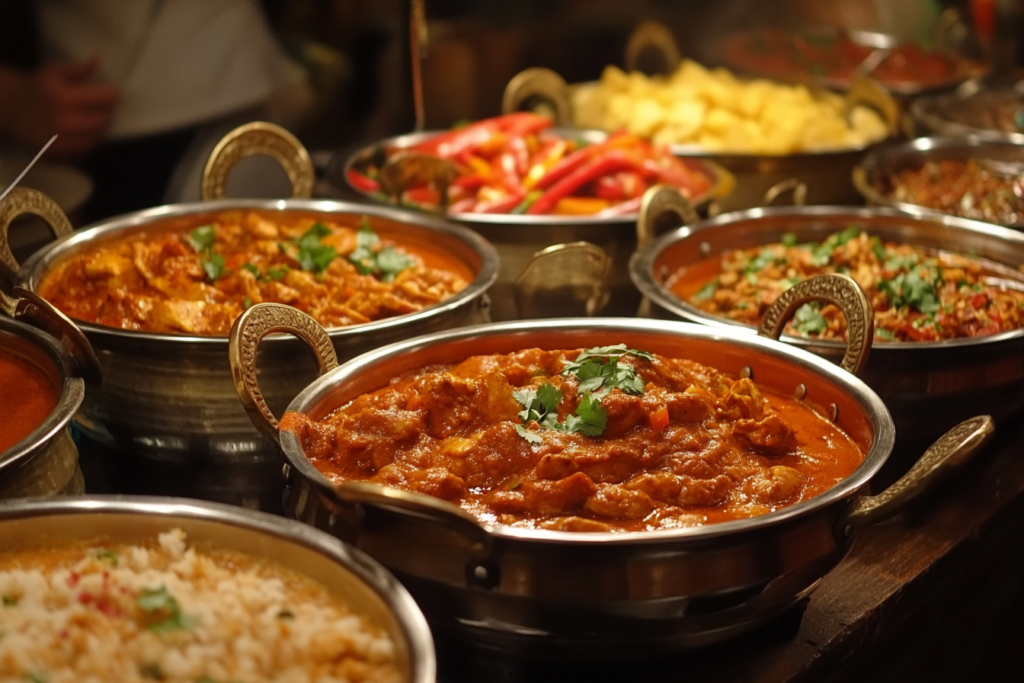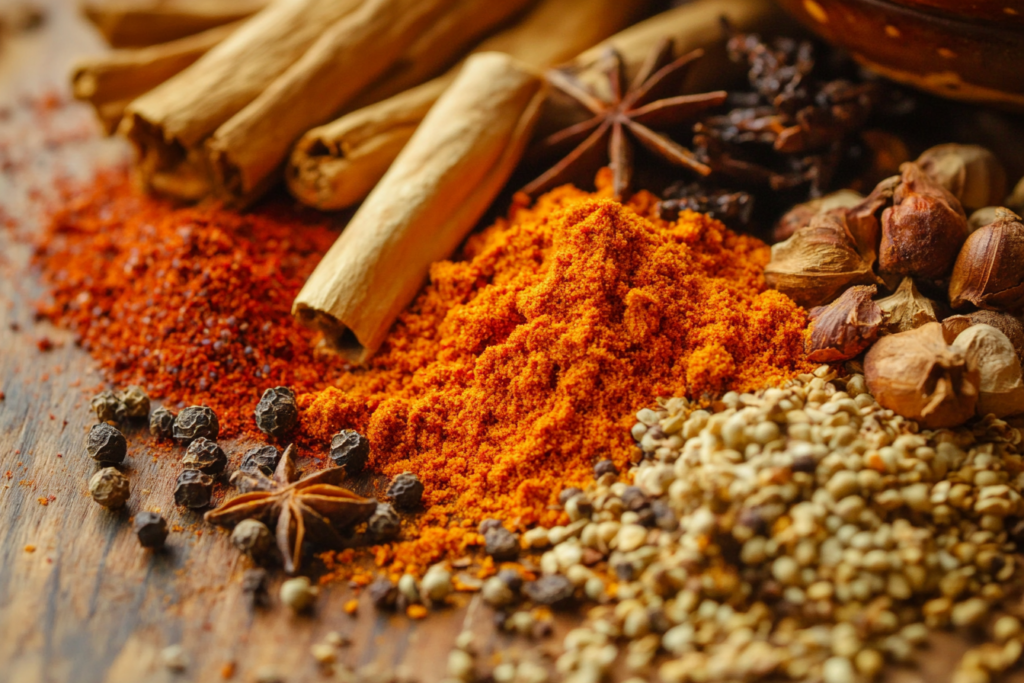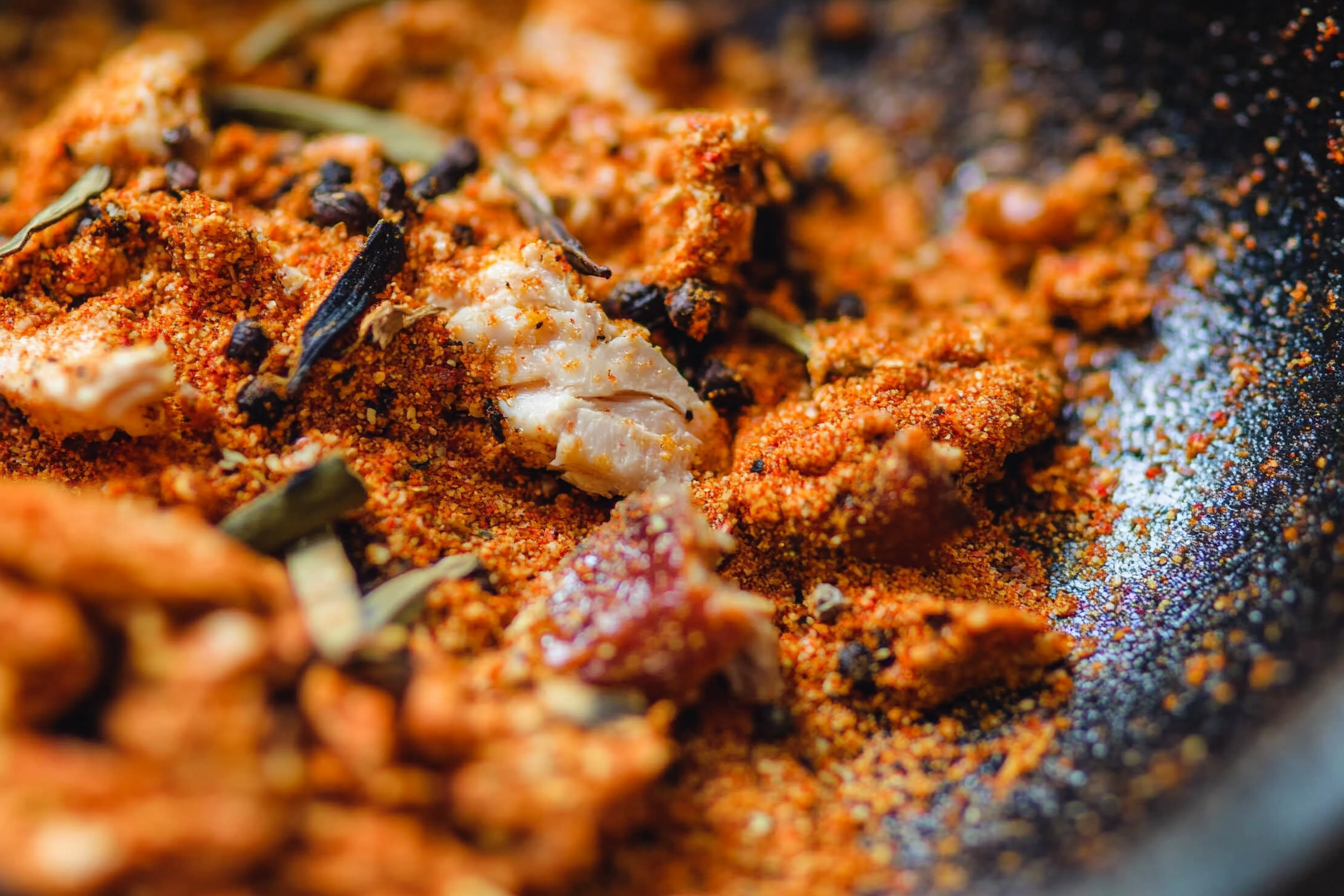Chicken Masala is a globally beloved dish, known for its rich flavors and aromatic spices. This guide explores everything from its origins to step-by-step preparation. Let’s dive into the world of Chicken Masala!
Part 1: Overview of Chicken Masala
1. What is Chicken Masala?
Chicken Masala is a flavorful Indian curry dish made with chicken, a blend of aromatic spices, and a rich, savory base. It’s versatile, often customized to regional tastes, and perfect for those who love bold flavors. The word masala refers to the mix of spices used, which is the soul of this dish.
2. Origins and Culinary Influence
Chicken Masala has roots in Indian cuisine, specifically influenced by Mughal cooking traditions. Over time, it has spread across the globe, with variations like the famous Chicken Tikka Masala gaining popularity in British and Western cuisines. Its influence highlights the diversity and adaptability of Indian food.
- Historical note: Chicken Masala’s origins are linked to the spice trade, which brought exotic flavors from India to the world.

3. Popular Types of Chicken Masala Recipes
There are countless ways to prepare Chicken Masala, with recipes varying by region. Some popular versions include:
- Butter Chicken Masala: Known for its creamy tomato gravy.
- Chettinad Chicken Masala: A fiery South Indian variation with coconut.
- Punjabi Chicken Masala: A rich and hearty North Indian curry.
4. Importance of Spices in Chicken Masala
Spices are the backbone of Chicken Masala. Each spice contributes a unique flavor profile:
- Turmeric: Adds earthiness and color.
- Cumin: Brings a warm, nutty aroma.
- Coriander: Offers a citrusy brightness.
- Garam Masala: A blend of several spices that ties the dish together.
The right balance of spices elevates the dish, creating its iconic depth of flavor.
5. Key Ingredients Overview
Here’s a quick rundown of the essential ingredients in Chicken Masala:
- Chicken: Typically bone-in for maximum flavor.
- Spices: Turmeric, cumin, coriander, garam masala, and chili powder.
- Aromatics: Garlic, ginger, and onions.
- Tomato Base: Fresh or pureed tomatoes.
- Dairy: Yogurt or cream for a velvety texture.
6. Understanding the Role of Masalas in Indian Cuisine
In Indian cooking, masalas (spice blends) are crucial. They add layers of flavor and define the dish’s identity. Chicken Masala showcases how a well-balanced masala can transform simple ingredients into a culinary masterpiece.
- Did you know? Regional masalas vary significantly, offering endless possibilities.
7. How Chicken Masala Differs Across Regions
Every region in India has its own version of Chicken Masala:
- North India: Creamy and rich, often using ghee and cream.
- South India: Spicier, with coconut milk or curry leaves.
- East India: Lighter gravies with mustard seeds.
- West India: Robust flavors with nutty elements like cashews.
These variations make Chicken Masala a true representation of India’s diverse culinary culture.
8. Nutritional Benefits of Chicken Masala Ingredients
Chicken Masala isn’t just delicious; it’s also packed with nutrients:
- Chicken: A great source of protein.
- Turmeric: Known for its anti-inflammatory properties.
- Tomatoes: Rich in antioxidants like lycopene.
- Garlic and Ginger: Boost digestion and immunity.
When prepared healthily, Chicken Masala can be a wholesome addition to your diet.
9. A Beginner’s Guide to Preparing Chicken Masala
For beginners, making Chicken Masala might seem daunting, but it’s straightforward with the right steps:
- Prep Ingredients: Gather and measure everything beforehand.
- Marinate the Chicken: Enhances flavor and tenderness.
- Sauté Aromatics: Brings out the depth of flavors.
- Cook with Patience: Allow the spices to blend harmoniously.
10. Cooking Techniques for Authentic Chicken Masala
Mastering Chicken Masala requires a few essential techniques:
- Tempering Spices: Heating spices in oil to release their aromas.
- Slow Cooking: Enhances the richness of the gravy.
- Balancing Flavors: Adjusting sweetness, heat, and acidity.
With practice, you’ll create a restaurant-quality Chicken Masala every time.

Part 2: Detailed Ingredient List
1. Protein: Choosing the Right Chicken Cut
The chicken you select significantly impacts the dish’s texture and flavor. Bone-in chicken is often preferred for Chicken Masala as it adds depth to the curry. However, boneless options like chicken thighs or breasts can also be used for convenience.
- Bone-in Chicken: Rich flavor due to marrow release.
- Chicken Thighs: Juicier and more forgiving than breasts.
- Chicken Breasts: Leaner but can dry out if overcooked.
Pro Tip: Always opt for fresh chicken over frozen for the best results.
2. Aromatic Spices: Overview of Core Spices
Spices are the essence of Chicken Masala, creating its rich and complex flavor. Here are the core spices:
- Turmeric: Adds a warm, earthy note and golden color.
- Cumin: Enhances the aroma with its nutty and slightly peppery profile.
- Coriander: Provides a fresh, citrusy taste.
- Garam Masala: A blend of spices that adds depth.
- Red Chili Powder: Adjusts the heat level.
Each spice should be measured carefully to maintain a balanced flavor profile.
3. Fresh Ingredients: Garlic, Ginger, and Onion
Aromatics like garlic, ginger, and onions form the base of most Chicken Masala recipes. They bring bold flavors and texture:
- Garlic: Adds a pungent aroma.
- Ginger: Provides a subtle spicy kick and freshness.
- Onions: Caramelized onions create a sweet and rich gravy.
Pro Tip: Sauté onions until golden brown for the best flavor.
4. Tomato Base: Using Fresh or Pureed Tomatoes
Tomatoes are essential for the gravy, offering acidity and a slight sweetness. Depending on your preference, you can use:
- Fresh Tomatoes: Provide a natural, tangy taste.
- Canned Tomatoes or Puree: Convenient and consistent in flavor.
Pro Tip: Cook tomatoes thoroughly to reduce rawness and enhance the dish’s complexity.
5. Dairy: Yogurt or Cream for Richness
Dairy products like yogurt or cream add a velvety texture and mellow out the spices:
- Yogurt: Tangy and slightly lighter, often used in traditional recipes.
- Cream: Creates a rich and indulgent curry.
You can use coconut cream for a dairy-free version while maintaining the luxurious texture.
6. Oils and Fats: Ghee vs. Vegetable Oils
The choice of fat affects both flavor and authenticity:
- Ghee (Clarified Butter): Offers a nutty, rich flavor and is a staple in North Indian cooking.
- Vegetable Oils: A neutral option for those who prefer lighter dishes.
Using a combination of both can balance flavor and health.
7. Herbs: Garnishing with Cilantro and Mint
Herbs like cilantro and mint are used as garnishes to add freshness and enhance the visual appeal of the dish:
- Cilantro: Adds a burst of freshness.
- Mint: Provides a cooling effect, especially in spicier versions.
Pro Tip: Chop herbs just before garnishing to preserve their aroma.
8. Optional Ingredients: Cashews, Coconut Milk, or Other Variations
While traditional recipes are straightforward, adding optional ingredients can elevate the dish:
- Cashew Paste: Adds creaminess and nutty sweetness.
- Coconut Milk: Common in South Indian variations for a tropical twist.
- Fenugreek Leaves (Kasuri Methi): Enhances aroma with a subtle bitterness.
Experiment with these additions to create your personalized Chicken Masala.
9. Premade Masala Blends vs. Homemade Spice Mixes
Premade spice blends offer convenience, but making your own ensures freshness and authenticity:
- Premade Blends: Easy to use and consistent.
- Homemade Mixes: Customizable and aromatic.
Pro Tip: If using store-bought masala, toast it lightly in oil to enhance its flavor.
10. Balancing the Heat: Using Green Chilies and Red Chili Powder
Controlling the heat is crucial for appealing to all palates. Both green chilies and red chili powder can be adjusted:
- Green Chilies: Add fresh heat and can be removed after cooking for a milder dish.
- Red Chili Powder: Provides a smoky and intense heat.
Balancing heat with sweetness (e.g., a dash of honey or sugar) can make the dish more palatable for everyone.
Why the Ingredients Matter
Each ingredient in Chicken Masala has a purpose, from building the foundation of flavors to enhancing texture and aroma. By carefully selecting and combining these components, you’ll create a dish that’s both authentic and tailored to your tastes.
The Ultimate Guide to Chicken Masala
Part 3: Step-by-Step Preparation
1. Marinating the Chicken for Maximum Flavor
The first step in creating a flavorful Chicken Masala is marinating the chicken. Marination not only tenderizes the meat but also infuses it with spices, ensuring every bite is packed with flavor.
- Ingredients for Marinade:
- Yogurt: Acts as a tenderizer.
- Turmeric, cumin, coriander: Essential spices.
- Garlic and ginger paste: For aromatic depth.
- Lemon juice: Adds acidity for tenderization.
Steps:
- Clean and pat the chicken dry.
- Mix yogurt, spices, garlic, ginger, and lemon juice in a bowl.
- Coat the chicken thoroughly and let it marinate for at least 2 hours or overnight.
Pro Tip: For deeper flavor, pierce the chicken with a fork before marinating.
2. Sautéing Spices to Release Aromas
Sautéing, or “tempering,” the spices is a crucial step. This process involves frying spices in hot oil to release their essential oils, enhancing the dish’s aroma.
- Steps:
- Heat oil or ghee in a pan.
- Add whole spices like cinnamon, bay leaves, and cardamom.
- Stir until the spices crackle and release their fragrance.
This step forms the aromatic base for the dish and sets the tone for its flavor profile.
3. Preparing the Tomato Gravy Base
The gravy base is the heart of Chicken Masala, providing its signature richness and depth.
- Ingredients:
- Finely chopped onions.
- Fresh or canned tomatoes.
- Garlic and ginger paste.
Steps:
- Sauté onions until golden brown.
- Add garlic and ginger paste and cook until the raw smell dissipates.
- Stir in pureed tomatoes and cook until the oil separates, indicating the base is ready.
Pro Tip: Add a pinch of sugar to balance the acidity of the tomatoes.
4. Cooking Chicken to Retain Juiciness
Cooking the chicken properly ensures it remains tender and juicy. Avoid overcooking, which can make the meat dry.
Steps:
- Add the marinated chicken to the gravy base.
- Stir to coat the chicken evenly with the masala.
- Cover and cook on medium heat until the chicken is fully cooked but still tender.
Pro Tip: Use a meat thermometer to ensure the internal temperature reaches 165°F (74°C).
5. Simmering and Adjusting Consistency
Simmering the curry allows the flavors to meld together. Adjust the consistency based on your preference:
- For a thicker gravy, simmer longer to reduce water.
- For a thinner curry, add warm water or stock gradually.
Steps:
- Reduce the heat to low and let the curry simmer for 10–15 minutes.
- Stir occasionally to prevent sticking.
Pro Tip: For added depth, stir in a small amount of garam masala during the final simmer.
6. Finishing Touches: Adding Cream or Yogurt
To make the Chicken Masala luxuriously creamy, finish with cream or yogurt.
Steps:
- Turn off the heat before adding cream or yogurt to prevent curdling.
- Stir gently until fully incorporated.
This step creates a velvety texture and balances the spices.
7. Garnishing for Presentation
Presentation is key, especially when serving guests. Fresh herbs and a drizzle of cream can elevate the dish visually.
- Options for Garnish:
- Chopped cilantro.
- Thinly sliced green chilies.
- A swirl of cream on top.
Pro Tip: Garnish just before serving to preserve the freshness of the herbs.
8. Serving Suggestions: Pairing with Rice or Bread
Chicken Masala recipes pairs perfectly with a variety of sides:
- Rice:
- Steamed basmati rice for a classic pairing.
- Jeera rice (cumin-flavored rice) for added aroma.
- Bread:
- Naan or roti for scooping up the curry.
- Paratha for a flakier, indulgent option.
Pro Tip: Warm the bread or rice before serving to enhance the overall dining experience.
9. Storage and Reheating Tips for Leftovers
Chicken Masala often tastes better the next day as the flavors continue to meld.
- Storage:
- Store in an airtight container in the refrigerator for up to 3 days.
- For longer storage, freeze in portions.
- Reheating:
- Use low heat on the stovetop, stirring occasionally.
- Add a splash of water or cream to restore the consistency.
Pro Tip: Avoid reheating multiple times to maintain freshness and flavor.
10. Common Mistakes to Avoid in Chicken Masala Recipes
Even experienced cooks can make mistakes. Avoid these common pitfalls:
- Overcooking Chicken: Leads to dry, rubbery meat.
- Under-sautéing Onions: Results in a raw, harsh flavor.
- Skipping the Marinade: Reduces depth of flavor.
- Adding Dairy at High Heat: Causes curdling.
- Using Premade Blends Without Enhancements: Misses the opportunity to deepen flavor.
By keeping these tips in mind, you’ll consistently achieve a perfect Chicken Masala.
More FAQs
- What type of chicken is best for Chicken Masala?
Bone-in chicken adds depth, while boneless options like thighs are more convenient. - Can I make Chicken Masala dairy-free?
Yes, use coconut milk or cashew paste instead of yogurt or cream. - What’s the difference between Chicken Masala and Chicken Curry?
Chicken Masala is spicier and uses a specific spice mix, while Chicken Curry is milder and more generic. - Is Chicken Masala gluten-free?
Yes, when made with gluten-free spices and ingredients. - How do I reduce the spiciness?
Use fewer chilies and add a dollop of cream or yogurt to mellow the heat. - Can I make it vegetarian?
Substitute chicken with paneer, tofu, or vegetables. - What’s the best oil for Spiced Chicken?
Ghee is ideal for flavor, but vegetable oil works for a lighter option. - How do I thicken the gravy?
Simmer longer or add cashew paste for a richer texture. - Can I use store-bought masala?
Yes, but toast it lightly in oil to enhance its flavor. - What sides pair best with Chicken Masala?
Steamed rice, naan, or paratha are excellent accompaniments.

